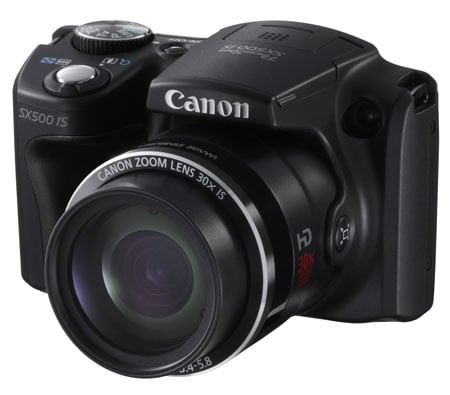Canon PowerShot SX500 IS review
-
-
Written by Ken McMahon
Verdict
The Canon PowerShot SX500 IS is the World’s smallest 30x optical zoom camera. It’s one of an emerging breed of compact super-zooms a lot smaller and a little simpler to operate than larger counterparts like the PowerShot SX50 IS and Panasonic FX60 / 62, but, like them, providing a huge focal length range.
The SX500 IS is fitted with the same 16 Megapixel CCD sensor and Digic 4 processor as the budget PowerShot models including the A810 and A1300. That means it lacks higher ISO sensitivities and hand-held Night Scene mode of the HS models that use the CMOS sensor and Digic 5 combination. But it has excellent image stablisation so don’t rule it out for low-light photography.
In addition to PASM exposure modes the SX500 IS has Smart Auto with scene detection and it also features Canon’s Creative filter effects, most of which can be used for shooting video as well as stills. The best quality video mode is 1280x720p at 25 frames per second and movies can be encoded using the efficient H.264 codec or Apple’s edit-friendly iFrame format. Note as a CCD model, there can be vertical streaking on videos with saturated highlights, such as strongly backlit windows or sunny reflections on rippling water. This may or may not be an issue for you.
But primarily this camera is really all about one thing, squeezing the biggest possible zoom range into the smallest, lightest body. That makes it very hard to ignore whichever of those criteria – size or zoom range – is top of your list. And it means it has the potential to attract buyers from both the compact super-zoom and so-called ‘bridge camera’ markets.
 |
Compared to Nikon COOLPIX L810
The Canon PowerShot SX500 IS and Nikon COOPIX L810 look quite similar, but are different in a number of fundamental respects. The COOLPIX L810 is a little bigger all round and, with 4 AA batteries as a power source also significantly heavier than the SX500 IS (but it also has much longer battery life).
The COOLPX L810’s zoom range is shorter, at 26x, than the PowerShot SX500’s, but it starts at a super-wide 22.5mm equivalent. If it’s telephoto reach that interests you though, there’s a significant gap between the maximum 585mm of the COOLPIX L810 and the 720mm of the SX500 IS.
Both cameras feature 3in LCD screens, the COOLPIX L810’s has a higher 921k pixel resolution, but that doesn’t help you see it better in bright sunlight where the PowerShot SX500 IS fares better. The SX500 also provides a far wider range of exposure modes making it better suited both to photographers who like to take control as well a those who like to experiment. The COOLPIX L810 is essentially a point-and-shoot super-zoom, lacking the SX500’s PASM modes as well as anything like its Creative filters.
Both cameras offer similar video capabilities with best quality 720p modes, but the SX500 can also apply its creative filters to video. And they also have similarly poor continuous shooting features, though in this instance the COOLPIX wins out, with its Best Shot Selector and Multi-shot 16 features.
In terms of image quality, there isn’t a great deal to choose between these two models, both of which are equipped with a 16 Megapixel CCD sensor. The COOLPIX has an edge at the base ISO sensitivity setting and its lens doesn’t suffer from chromatic aberration to the extent that the SX500 IS does. I should also mention at this point that as an older model, the L810 is currently available at a lower price.
See my upcoming Nikon COOLPIX L810 review for more details.
Canon PowerShot SX500 IS final verdict
The PowerShot SX500 IS provides an unbeatable combination of massive zoom range in a compact lightweight body that, for now at least, is unmatched by anyone else. If you want a smaller camera, you’ll need to make a compromise on zoom range and if you want a longer zoom range you’ll be carrying a bigger, heavier camera.
With PASM exposure modes, Creative filters, and Live Control, the SX500 IS caters for the needs of point-and-shoot casual snappers as well as more demanding photographers. The latter may be disappointed at Canon’s decision to opt for the 16 Megapixel CCD sensor rather than the 12.1 or 16.1 Megapixel CMOS sensor which offers better low light performance, stacking modes and avoidance of vertical streaks on bright highlights in videos. A CMOS sensor would also have addressed another of the SX500 IS’s weak spots – its continuous shooting performance. It would also, of course, have increased the price.
As it stands the Canon PowerShot SX500 IS provides a compelling blend of features in compact and well designed body at a price that makes it hard to ignore. I wouldn’t mind betting that many people who start out with different ideas about what they wanted from a super-zoom end up buying a PowerShot SX500 IS and I highly recommend it.
Bad points | Scores (relative to 2012 super-zooms) |
 | ||
Build quality: Image quality: Handling: Specification: Value:
Overall: |
17 / 20 16 / 20 17 / 20 18 / 20 17 / 20
85% | |||





